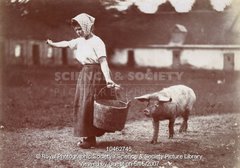07.sep.08
infoZine
Jim Low
http://www.infozine.com/news/stories/op/storiesView/sid/30483/
More than 400 feral hogs have been trapped, snared or shot on state land since January, and eradication work is getting more efficient as workers gain experience tracking down elusive, prolific porkers.
The legal definition of a "feral" hog is one that is unconfined and has no conspicuous ownership markings, such as ear tags or ear notching. Small numbers of free-ranging swine without owners have existed in Missouri for many years. They became a source of concern when people began releasing hogs to establish huntable populations. Feral hog numbers have burgeoned in some areas - especially national forest land and conservation areas (CAs).
Besides being illegal, releasing pigs to run free threatens native plant and animal life. Feral hogs also carry diseases that can infect domestic swine and humans.
Gov. Matt Blunt lent urgency to feral-hog eradication efforts last year when he set up a multi-agency Governor's Task Force on Feral Hogs to deal with the problem. The Conservation Department already was working to eliminate feral hogs from its property. The task force has brought these efforts together with financial and staff support from the Missouri departments of Agriculture and Natural Resources, the U.S. Army Corps of Engineers and the U.S. Department of Agriculture's Animal and Plant Health Inspection Service and Forest Service.
Private Lands Field Programs Supervisor Rex Martensen said the Conservation Department launched simultaneous feral hog eradication operations on a dozen or so CAs in southern Missouri in January. Techniques used included corral-type traps with one-way doors, snares, sharpshooting, hunting with hounds and aerial gunning from helicopters.
"None of these methods is enough by itself," said Martensen. "Traps work for a short time in an area and then the rest of the hogs get shy of them. After that you try to clean out the remainder with the other methods."
He said snaring has turned out to be much more effective than expected, accounting for most of the 300 feral hogs captured at Ketcherside Mountain CA in Iron County."We knew how to use snares at fence crossings for coyotes, but we were not sure how they would work in open areas," Martensen said. "Our crews showed remarkable resourcefulness in adapting them to unfenced terrain, and we caught lots of hogs that way."
Another pleasant surprise was the effectiveness of aerial gunning in hilly terrain. Martensen said this technique probably always will be better suited to flat, open country, but in at least one instance it worked to perfection in the Ozarks.
A group of 11 hogs on one area had eluded ground crews for weeks, so the Conservation Department brought in its helicopter in spite of the fact that the terrain was not considered ideal for aerial gunning. With no leaves on the trees, the helicopter crew found the animals in five minutes and the pilot was able to herd the pigs up a hillside until they were level with the gunner, who killed all 11.
"They were done in 30 minutes," said Martensen. "Flying a helicopter is expensive, but with that kind of efficiency it compares very favorably with having ground-based crews bait an area every day for a week and a half and going after the animals with traps and snares."
Martensen said hogs effectively have been eradicated from 3,356-acre Ketcherside CA, where they posed a threat to the largest remaining population of Meade's milkweed, an endangered plant. He said a few pigs have been seen on the area in the past few months, but those are believed to be strays from the surrounding area.
One disappointment so far is the use of "Judas hogs." This involves catching one pig in a live trap and fitting it with a radio transmitter collar. The theory is that the collared hog gets back together with the rest of the herd, enabling hunters to locate and kill several hogs at once.Young female hogs are thought to be the most social, so they were used as the first three Judas hogs. But it turned out that two of the three had only occasional, temporary contact with other hogs. The third has been with other hogs, but they have been hard to kill in spite of their whereabouts being known.
Other areas where the Conservation Department has had success killing hogs include the areas around Wappapello and Truman lakes. According to Martensen, most of the pigs that have been killed looked like black Russian boars. Some areas were populated by spotted pigs or reddish pigs that resemble domestic breeds. The average feral hog taken weighed around 150 pounds. The largest weighed approximately 350 pounds. Where practical, hog carcasses have been donated to area residents. The rest were buried.
Martensen said his agency has killed more feral hogs already this year than it did in the previous five years. He said the success of coordinated feral hog eradication efforts is an encouraging sign that Missouri might be able to get its feral-hog problem under control.
"The world is a dangerous place, not because of
those who do evil, but because of those who look on
and do nothing".
- Albert Einstein
those who do evil, but because of those who look on
and do nothing".
- Albert Einstein

Subscribe to:
Post Comments (Atom)















No comments:
Post a Comment